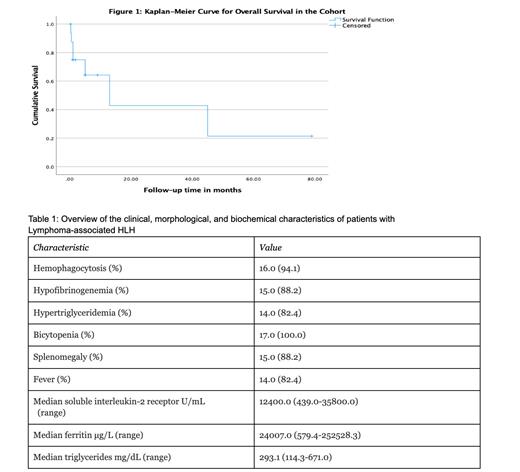Introduction: Lymphoma encompasses a prominent cause of secondary hemophagocytic lymphohistiocytosis (HLH), an aggressive hyperinflammatory syndrome characterized by immune dysregulation. The concurrence of lymphoma and HLH represents a challenging entity due to the ambiguity of clinical features and paucity of standardized treatment regimens. Limited data exists regarding the characteristics and outcomes of secondary HLH within the Middle East and Saudi Arabia. Moreover, the structure of the population within our region, characterized by a predominance of males and young adults, offers a unique perspective to the literature regarding secondary HLH. Herein, we evaluate the clinical features and outcomes of patients presenting with HLH secondary to lymphoma at a tertiary center in Saudi Arabia.
Methods: We retrospectively reviewed the electronic medical records of patients diagnosed with lymphoma over the past ten years at our center to identify patients who developed secondary HLH. The Kaplan-Meier method was used to estimate median overall survival (OS). OS was defined as the incidence of death from any cause from the onset of HLH diagnosis until the end of follow-up. The Cox proportional hazards model was used to identify demographic, clinical, and treatment associated prognostic indicators which had a significant impact on OS.
Results: A total of 1484 patients with lymphoma were identified, of which seventeen (1.1%) patients had concurrent HLH. Of the seventeen patients, the median age was 42 years (range 17-64) with 5 (29.4%) patients aged 50 and over. Interestingly, all 17 (100.0%) patients within our cohort were male. Regarding lymphoma subtypes, 10 (58.8%) patients had T and NK-cell lymphoma, 5 (29.4%) had B -cell lymphoma, and 2 (11.7%) had Hodgkin lymphoma. The median HScore was 272.0 (range 182-337) whereas the median HLH-2004 diagnostic criteria score was 6 out of 8 points (range 4-8). Hemophagocytic features in the bone marrow were present in 13 (76.5%) patients. Epstein-Barr virus infection was detected in 9 (52.9%) patients with a median quantitative PCR level of 37347.5 IU/mL (range 1960.0-402847.0). HLH therapy utilized in our patient sample included corticosteroids in 15 (88.2%) patients, etoposide in 8 (47.1%) patients, and intravenous immunoglobulin in 3 (17.6%) patients. Death occurred in 7 (41.2%) patients whilst the median OS of the cohort was 13.0 months (95% CI 0.0-27.4). Using the cox proportional hazards model, both age ≤50 years (P=0.04, hazard ratio=0.186) and etoposide administration (P=0.002, hazard ratio=0.011) were associated with significantly improved survival.
Conclusions: To our knowledge, this is the first cohort study reporting the clinical features and outcomes of HLH secondary to lymphoma within our region. Our study highlights the significant disparities between our population and other countries across the globe as our cohort demonstrated a significant male predominance as well as a relatively young median age at diagnosis. Nonetheless, the survival outcomes of secondary HLH remain poor despite the advances in the diagnostication and recognition of the disease. Future efforts ought to explore both the pathophysiological mechanisms underlying lymphoma-associated HLH and the efficacy of different targeted therapeutic modalities.
Disclosures
Alzahrani:Kite: Consultancy, Speakers Bureau.


This feature is available to Subscribers Only
Sign In or Create an Account Close Modal